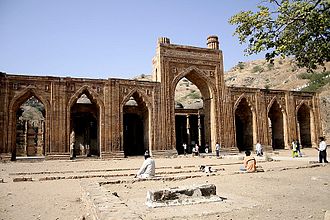Adhai-din-ka-Jhonpra Mosque
The Adhai-din-ka-Jhonpra Mosque in Ajmer ( Rajasthan ) is - next to the Quwwat-ul-Islam Mosque in the Qutb Minar complex of Delhi , which was built around the same time - the oldest mosque in the north of the Indian subcontinent.
location
The mosque is located in the southwest of the city of Ajmer at the foot of a hill. From the city center it is about 2500 m on foot or by rickshaw ; from the train station it is only about 1000 m.
history
After the conquest of Northwest India by the Ghurid General Qutb-ud-Din Aibak in 1192/3, he had many Hindu and Jain temples torn down. Some of the pillars were reused as spoilers in the newly built mosques of Delhi and Ajmer. The seven-arched portal barrier as well as the entrance portal date from the time of Iltutmish , the son-in-law and successor of Qutb-ud-Din Aibak; they were built around 1220/30.
architecture
portal
The entrance portal, built around 1220/30, is divided in two by a mighty stone lintel made up of several parts ; its lower area is adorned with a large calligraphy field, which is framed by several differently designed braided bands. Above that there is a wave-shaped motif with inlaid rosette decoration . A frieze with multi-tiered cross motifs forms the end of the lintel beam. The keel arch of the portal above is in corbel technique , i.e. H. without a stabilizing keystone , executed and decoratively bordered on top and on both sides; the gussets on both sides contain abstract-vegetable patterns and two clearly protruding rosettes.
patio
The side lengths of the square inner courtyard ( sahn ), surrounded by arcades ( riwaqs ), measure around 78 meters. The courtyard was formerly covered with stone slabs; some trees gave the believers a little shade during prayer. The middle of the courtyard was formerly occupied by a large square fountain basin for the little ablution ( wuduʾ ) prescribed by the Koran (sura 5,6) before prayer ; Here is the cenotaph of an unknown Muslim dignitary (perhaps an imam ), added later , who was not allowed to be buried in the cemetery, but - as a special tribute - in the mosque courtyard.
Arcade barrier
The most eye-catching feature is the seven-arched and approximately 60-meter-wide arcade barrier in front of the prayer hall. It has a clearly Islamic design language - both in the overall concept and in the ornamental and calligraphic decorative elements. The approximately 18 meter high central arch is - in Persian style - raised compared to the side arches ( Ivan motif) and ends in a pointed arch; there are two truncated columns as essays, but they could not be used as minarets . The six lateral arches are significantly narrower and partly end with multi-pass arches at the top . All surfaces are covered in horror vacui style over and over with abstract-vegetable ornaments (including many braided ribbon motifs ) and calligraphies with quotations from the Koran .
Prayer hall
The oldest part of the mosque is the one facing west, i.e. H. to Mecca aligned prayer hall. It consists of many almost two meter high Hindu or Jain pillars, which - each placed three times on top of each other - result in a total height of the hall of around 6.90 meters. The prayer hall is essentially flat-roofed; however, the yoke in front of the mihrab niche is covered by a cantilever dome in Hindu style. Since all pillars of the prayer hall are largely designed in the same way, there is also the possibility that at least some of them were made by Hindu stonemasons especially for the new mosque.
literature
- Alfred Renz: Islam. History and sites of Islam from Spain to India. Prestel-Verlag, Munich-London-New York 1977, ISBN 3-7913-0360-0 , pp. 655ff.
Web links
- Adhai Din ka Jhonpra Mosque - photos + information
- Adhai Din ka Jhonpra Mosque - Photos + Info (Archnet, Engl.)
Coordinates: 26 ° 27 ′ 20 ″ N , 74 ° 37 ′ 40 ″ E


